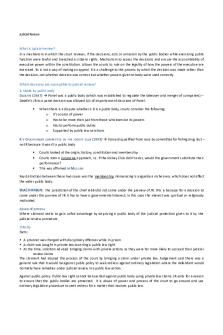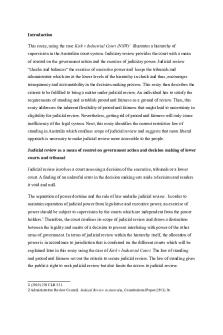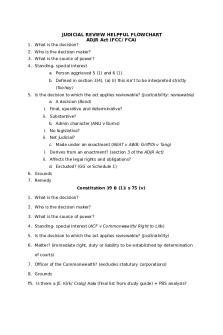Judicial Review PDF

| Title | Judicial Review |
|---|---|
| Course | Administrative Law |
| Institution | University of Tasmania |
| Pages | 7 |
| File Size | 190.1 KB |
| File Type | |
| Total Downloads | 116 |
| Total Views | 866 |
Summary
IntroductionThis essay, using the case Kirk v Industrial Court (NSW) 1 illustrates a hierarchy of supervision in the Australian court system. Judiciary review provides the court with a mean of control on the government action and the exercise of judiciary power. Judicial review “checks and balances”...
Description
Introduction This essay, using the case Kirk v Industrial Court (NSW)1 illustrates a hierarchy of supervision in the Australian court system. Judiciary review provides the court with a mean of control on the government action and the exercise of judiciary power. Judicial review “checks and balances” the exercise of executive power and keeps the tribunals and administrator which are at the lower levels of the hierarchy in check and thus, encourages transparency and accountability in the decision making process. This essay then describes the criteria to be fulfilled to bring a matter under judicial review. An individual has to satisfy the requirements of standing and establish procedural fairness as a ground of review. Then, this essay addresses the inherent flexibility of procedural fairness that might lead to uncertainty in eligibility for judicial review. Nevertheless, getting rid of procedural fairness will only cause inefficiency of the legal system. Next, this essay identifies the current restrictive law of standing in Australia which confines scope of judicial review and suggests that more liberal approach is necessary to make judicial review more accessible to the people. Judicial review as a mean of control on government action and decision making of lower courts and tribunal Judicial review involves a court assessing a decision of the executive, tribunals or a lower court. A finding of an unlawful error in the decision making sets aside a decision and renders it void and null. The separation of power doctrine and the rule of law underlie judicial review. In order to maintain separation of judicial power from legislative and executive power, an exercise of power should be subject to supervision by the courts which are independent from the power holders.2 Therefore, the court confines its scope of judicial review and draws a distinction between the legality and merits of a decision to prevent interfering with power of the other arms of government. In terms of judicial review within the hierarchy itself, the allocation of power is in accordance to jurisdiction that is conferred on the different courts which will be explained later in this essay using the case of Kirk v Industrial Court. The law of standing and procedural fairness set out the criteria to secure judicial review. The law of standing gives the public a right to seek judicial review but also limits the access to judicial review.
1 (2010) 239 CLR 531. 2 Administrative Review Council, Judicial Review in Australia, Constitutional Paper (2011) 36.
Procedural fairness requires that the proceedings be conducted according to a standard of fairness. A breach of the procedural fairness gives a basis of claim for judicial review. The hierarchy of supervision The case Kirk v Industrial Court (NSW) illustrates a system of supervision to control tribunals and administrators- that tribunals of limited jurisdiction are subject to the courts of more general jurisdiction.3 The “islands of power immune from supervision of restraint” refers to jurisdictional error that falls outside the hierarchy of supervision. Jurisdictional error encompasses a wide range of grounds including breach of procedural fairness. Jurisdictional error can also occur when an inferior court commits jurisdictional error if it denies existence of jurisdiction or disregards the limits of its functions or power even when it recognizes the existence of jurisdiction when making a decision.4 Jurisdictional error is not only a category of error that provides for grounds of review, but it also marks out a territory where no privative clauses can reach.5 As illustrated in Kirk v Industrial Court, the operation of the hierarchy can be examined from two aspects. Firstly, Chapter 3 of the Constitution includes States Supreme Court and protects its supervisory jurisdiction from legislative interference. The power to supervise the decision making of the lower hierarchy and control government action by issuing remedies is one of the defining characteristics of the supreme courts and one that cannot be taken away by state legislation or privative clauses as suggested by the separation of power doctrine.6 Secondly, there is a single Australian common law. High Court is at the apex of the judicial system. The supervisory jurisdiction of a State Supreme Court is equivalent of the High Court jurisdiction under section 75(5) of the Constitution.7 In linking the superintendence of the supervisory jurisdiction of the supreme courts with the High Court’s responsibility to maintain a unified common law, the High Court warns against the removal of the supervisory jurisdiction of supreme courts.8 Depriving a supreme court of its supervisory jurisdiction to control the government action will result in “distorted positions” within the hierarchy.9 3 (2010) 239 CLR 531. 4 Ibid,573. 5 Cheryl Saunders, ‘Constitution as Catalyst: Different Paths Within Australasian Administrative Law’ (2010) 10 New Zealand Journal of Public and International Law 143. 6 Wendy Lacey,’ Breathing Life into Kable’ (2010) 34 Melbourne University Law Review 642, 649. 7 Justice John Basten, ‘Jurisdictional Error after Kirk: Has it a Future?’ (Paper presented at Supreme and Federal Court Judges’ Conference, Melbourne, 21-25 January 2012). 8 Above n 6, 657. 9 Kirk v Industrial Court of New South Wales (2010) 239 CLR 531, 581.
Kirk v Industrial Court predominantly addresses the supervision of the exercise of power of the executive. This essay, however, address the role of judicial review in controlling both the exercise of power of executive and judiciary. Procedural fairness as a ground of review The Administrative Decisions ( Judicial Review) Act 1977 (ADJR Act) provides a structure for judicial review. Section 5 of the ADJR Act lists 18 grounds on which a decision can be set aside by the courts. Natural justice, which is also known as procedural fairness, being placed as the first ground shows its importance in Australian administrative law. It is essential to the making a good decision in the interest of the parties. Procedural fairness is made up of two limbs. Firstly, the hearing rule requires both sides to be heard. Secondly, the bias rule requires a matter be determined without bias. Bias in a judge vitiates a decision making and results in jurisdictional error.10 A denial of procedural fairness is jurisdictional error which is subject to review. Similarly, procedural fairness is also essential in the reviewing of a decision. Without adhering to these rules in a judicial review, the courts simply repeat the process that the primary decision maker follows and therefore, unlikely to make a better decision.11 An example of procedural fairness is legitimate expectation. In Minister for Immigration and Multicultural Affairs ex parte Lam,12 the High Court considers the role legitimate expectation to determine the precise content of procedural fairness. Legitimate expectation does not give rise to substantive expectations and outcomes but only imposes procedural requirement.13 In that case, the courts draw distinction between substantive right and procedural right. They reason that if a mere intention bounds that person to that course of action, then that expectation that the action would be carried out turns into a substantive right.14 This distinction is necessary to ensure fairness and prevents the floodgate of claims submitted for judicial review. Flexibility of procedural fairness maneuvered by decision makers to avoid judicial review
10 Deirdre O’Connor, ‘Is There Too Much Natural Justice?’ (1994) 1 Australian Institute of Administrative Law Forum 81. 11 Ibid. 12 (2003) 195 ALR 502. 13 Heny Burmester , ‘Teoh Revisited After Lam’ (2004) 40 Australian Institute of Administrative Law Forum 33. 14 Minister for Immigration and Multicultural Affairs ex parte Lam (2003) 195 ALR 502.
Procedural fairness is flexible dependent on the interpretation of statute and circumstances of the case. The nature of hearing varies, ranging from judicial-style hearing with legal proceedings to administrative style hearing with an exchange of correspondence between government agency and the individual.15 This flexibility might result in wide discretion on the decision makers in controlling the proceedings so as to prevent denial of procedural fairness. As such, decision makers tend to apply the maximum rules of procedural fairness to avoid being subject to judicial review.16 This results in the proceedings of tribunals or courts to emphasize more on the procedures than on the question of fairness.17 This undermines the purpose of tribunals which are required to conduct proceedings in a more informal manner than the courts in order to make merits review more accessible to the general public. Moreover, the decision makers are unsure whether they are abiding by the law due to the flexibility of procedural fairness.18 Trivial errors, when subject to judicial review, may invalidate a decision made in good faith.19 The Australian approach in categorizing errors of law as jurisdictional and non-jurisdictional also leads to uncertainty in government decision making. This is because the decision makers are unable to determine the scope of their own jurisdiction because of the Court’s interpretation of separation of power.20 However, the fact that an obligation to accord procedural fairness is implied from the statute prevents decisions from being invalidated by unpredictable judicial assessment of what procedural fairness requires in particular circumstances.21 Instead, the courts acknowledge that legislation may limit the requirements of procedural fairness by statutory interpretation. In Kioa v West,22 the courts adopt the ‘threshold test’ to determine the legislature’s intention to condition the relevant decision makers to observe procedural fairness.23 A failure to determine an intention as such renders the legislation invalid and constitutes jurisdictional error.24 A review on the breach of procedural fairness also depends on the legislature’s intention that an exercise of
15 Robin Creyke and John McMillan, Control of Government Action( LexisNexis, 3rd ed, 2012). 16 Above n 10. 17 Ibid. 18 Margaret Kelly, ‘ Does the expansion of judicial review pose a threat to democratic governance?’ ( Paper presented at the Australian Institute of Administrative Law National Administrative Law Conference: Democracy, Participation and Administrative Law, 22 July 2011). 19 Ibid. 20 Above n 18, 35. 21 Justice John Basten, ‘Limits on Procedural Fairness” (2005) Australian Institute of Administrative Law Forum. 22 (1985) 159 CLR 550. 23 Plaintiff S10/2011 v Minister for Immigration and Citizenship (2012) 246 CLR 636. 24 Above n 5.
power is only valid if procedural fairness is observed.25 Justice Brennan comments in Kioa v West that the flexibility of procedural fairness also suggests that the law of standing may also be relevant in the application of procedural fairness.26 Therefore, the issue may be whether an individual has a special interest in the subject matter of the case. Legality-merit distinction limits court’s role and restricts procedural fairness The doctrine of jurisdictional error draws a distinction between the legality and merits of a decision which is essential to maintain the separation of powers. The increasing focus on legality prevents Australian courts from trespassing upon the merits of administrative decision-making.27 The limitation to confine the courts to questions of law limits the scope of judicial review and thus, constrains the grounds of judicial review, which in this case is the adoption of procedural fairness.28 However, the distinction between legality and merits is sometimes blurred by grounds of review such as the procedural fairness because the courts have different opinions on applying the proper scope and application of those grounds of review in particular cases.29 Although the High Court is responsible for confining the courts within their supervisory jurisdiction when reviewing a decision, the broad approach taken by the courts necessitates the interference of the legislature in confining the scope of judicial review so as to restrict the ability of the court to second-guess the decisions made by tribunals and administrators.30 Nonetheless, a trend in recent years shows that Australian courts have been more willing to grant relief in judicial review for a breach of procedural fairness. This is inconsistent with the limits on the scope of judicial review of administration action and the courts’ reluctance to interfere with the executive role and thereby, expanding the rule of law.31 Standing to seek judicial review A breach of procedural fairness affects the interest, right and legitimate expectation of a person and grants him standing to bring a case before the court. The hearing rule of procedural fairness that requires a notice be given about a decision made “adversely affects the rights, interests or legitimate expectations” of a person inevitably overlaps with the rules 25 Kristina Stern ‘ Procedural Fairness-Its Scope and Practical Application’ (2007) 56 Australian Institute of Administrative Law Forum 2. 26 Ibid. 27 Ibid. 28 Above n 5. 29 David Bennett, ‘Balancing Judicial Review and Merits Review’ (Paper presented at an administrative law conference, 27 September 1999). 30 Ibid. 31 Above n 25.
of standing.32 Consistent with the hearing rule, the law of standing requires that procedural fairness be afforded by judicial review to a person whose interest are adversely above those of an ordinary member of the public. This can be determined by the ‘special interest’ test under common law.33 The law of standing in Australia restricts the scope of judicial review The restrictive law of standing acts as a barrier to seeking judicial review. In particular, the 'special interest' test is unpredictable, inconsistent and based largely on subjective value judgements. This can make the legal system appear unfair, inefficient and ineffective.34 The courts and the legislation have acknowledged the need for a broader approach in determining whether a person has ‘standing’ to seek judicial review. A wider law of standing broadens the scope of judicial review and encourages accountability in decision making in accordance to the law. 35 In Bateman’s Bay Local Aboriginal Land Council v Aboriginal Community Benefit Fund Pty Ltd,36 instead of the ‘special interest’ test, the courts suggest a test where “the proceedings should be dismissed because the right or interest of the plaintiff was insufficient to support a justiciable controversy, or should be stayed as otherwise oppressive, vexatious or an abuse of process.” Likewise, legislature starts to adopt a wider law of standing. This is evident in most environment protection acts and consumer protection legislations. For example, the Environmental Protection and Biodiversity Conservation Act (Cth) and the Trade Practices Act 1974 (Cth) are designed to provide for wider rules of standing for the public to enforce its provisions. Consistent with the views of the court and legislation, the Australian Law Commission recommends a broader standing rule to permit any person who is no “merely meddling” to commence proceedings.37 The Commission also recommends uniform standing laws throughout Australia to avoid unnecessary confusion and increase the effectiveness of the legal system.38 Conclusion
32 Ibid. 33 Tooheys Ltd v Minister for Business and Consumer Affairs (1981) 36 ALR 64. 34 Australian Law Reform Commission, Beyond the Doorkeeper - Standing to Sue for Public Remedies Report No 78 (1996). 35 Above n 2, 83. 36 (1998) 194 CLR 247. 37 Australian Law Reform Commission, Standing in Public Interest Litigation ,Report No 27 (1985). 38 Above n 32.
In conclusion, the key concepts in this essay namely judicial review, procedural fairness and standing all serve to achieve good administration by increasing accountability within the hierarchy and also between the different arms of government. On balance, despite the limitations of procedural fairness and the narrow law of standing, they are indispensable to provide access to judicial review which has proven to be effective in restraining and supervising the exercise of power by other bodies than the court....
Similar Free PDFs

Judicial Review
- 15 Pages

Judicial Review
- 50 Pages

Judicial Review
- 6 Pages

Judicial Review
- 40 Pages

Judicial Review
- 7 Pages

Judicial Review Complete 2
- 54 Pages

Judicial Review (ALL!)
- 8 Pages

Judicial Review- irrationality
- 4 Pages

Judicial Review notes
- 1 Pages

Analisis Sejarah Judicial Review
- 5 Pages

ADMIN LAW Judicial Review
- 5 Pages

Ilegality - Judicial Review
- 5 Pages

Judicial Review Notes
- 6 Pages

Judicial Review Essay
- 3 Pages

Judicial Review Flowchart
- 4 Pages
Popular Institutions
- Tinajero National High School - Annex
- Politeknik Caltex Riau
- Yokohama City University
- SGT University
- University of Al-Qadisiyah
- Divine Word College of Vigan
- Techniek College Rotterdam
- Universidade de Santiago
- Universiti Teknologi MARA Cawangan Johor Kampus Pasir Gudang
- Poltekkes Kemenkes Yogyakarta
- Baguio City National High School
- Colegio san marcos
- preparatoria uno
- Centro de Bachillerato Tecnológico Industrial y de Servicios No. 107
- Dalian Maritime University
- Quang Trung Secondary School
- Colegio Tecnológico en Informática
- Corporación Regional de Educación Superior
- Grupo CEDVA
- Dar Al Uloom University
- Centro de Estudios Preuniversitarios de la Universidad Nacional de Ingeniería
- 上智大学
- Aakash International School, Nuna Majara
- San Felipe Neri Catholic School
- Kang Chiao International School - New Taipei City
- Misamis Occidental National High School
- Institución Educativa Escuela Normal Juan Ladrilleros
- Kolehiyo ng Pantukan
- Batanes State College
- Instituto Continental
- Sekolah Menengah Kejuruan Kesehatan Kaltara (Tarakan)
- Colegio de La Inmaculada Concepcion - Cebu
